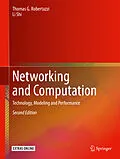This revised textbook, intended for use in undergraduate/graduate courses on computer networking, computer systems/architecture and performance evaluation, presents a host of new and revised content and ancillaries. This text presents a balanced approach between technology and mathematical modeling. It covers networking algorithms (routing, error codes, protocol verification, line codes, network coding and quantum encryption) and analysis (probability for networking with technological examples, queueing models, divisible load scheduling theory and Amdahl's Law). There is also a tutorial chapter providing insights into machine learning for networking, the cutting edge of networking technology.
This self-contained text progresses systematically and gives students numerous examples at the end of each chapter. Students in electrical engineering, computer engineering and computer science departments will benefit from this book as will engineers and computer scientists working in relevant fields.- Maintains a balanced approach between technology and mathematical modeling
- Features new and revised content covering the latest advances in the field since the original publication
- Includes a host of classroom material for students and instructors
Autorentext
Thomas G. Robertazzi received the Ph.D from Princeton University, Princeton, NJ, in 1981 and the B.E.E. from the Cooper Union, New York, NY in 1977. A Fellow of the IEEE, he is presently a Professor in the Dept. of Electrical and Computer Engineering at Stony Brook University, Stony Brook N.Y. He has published extensively in the areas of parallel processing and grid scheduling, ad hoc radio networks, telecommunications network planning, switching , queueing and Petri networks. Prof. Robertazzi has also authored, co-authored or edited six books in the areas of networking, performance evaluation, scheduling and network planning. For eleven years Prof. Robertazzi was the faculty director of the Stony Brook Living Learning Center in Science and Engineering. Since 2008 he has been co-chair of the Stony Brook University Senate Research Committee.
Klappentext
This useful volume adopts a balanced approach between technology and mathematical modeling in computer networks, covering such topics as switching elements and fabrics, Ethernet, and ALOHA design. The discussion includes a variety of queueing models, routing, protocol verification and error codes and divisible load theory, a new modeling technique with applications to grids and parallel and distributed processing. Examples at the end of each chapter provide ample material for practice. This book can serve as an text for an undergraduate or graduate course on computer networks or performance evaluation in electrical and computer engineering or computer science.
Inhalt
Introduction.- A Tour through Networking and Computing.- Fundamental Stochastic Models.- Queueing Models.- Fundamental Deterministic Algorithms.- Divisible Load Modeling for Grids.- Amdahl's and Related Laws.- Machine Learning for Networking.- Conclusion.
